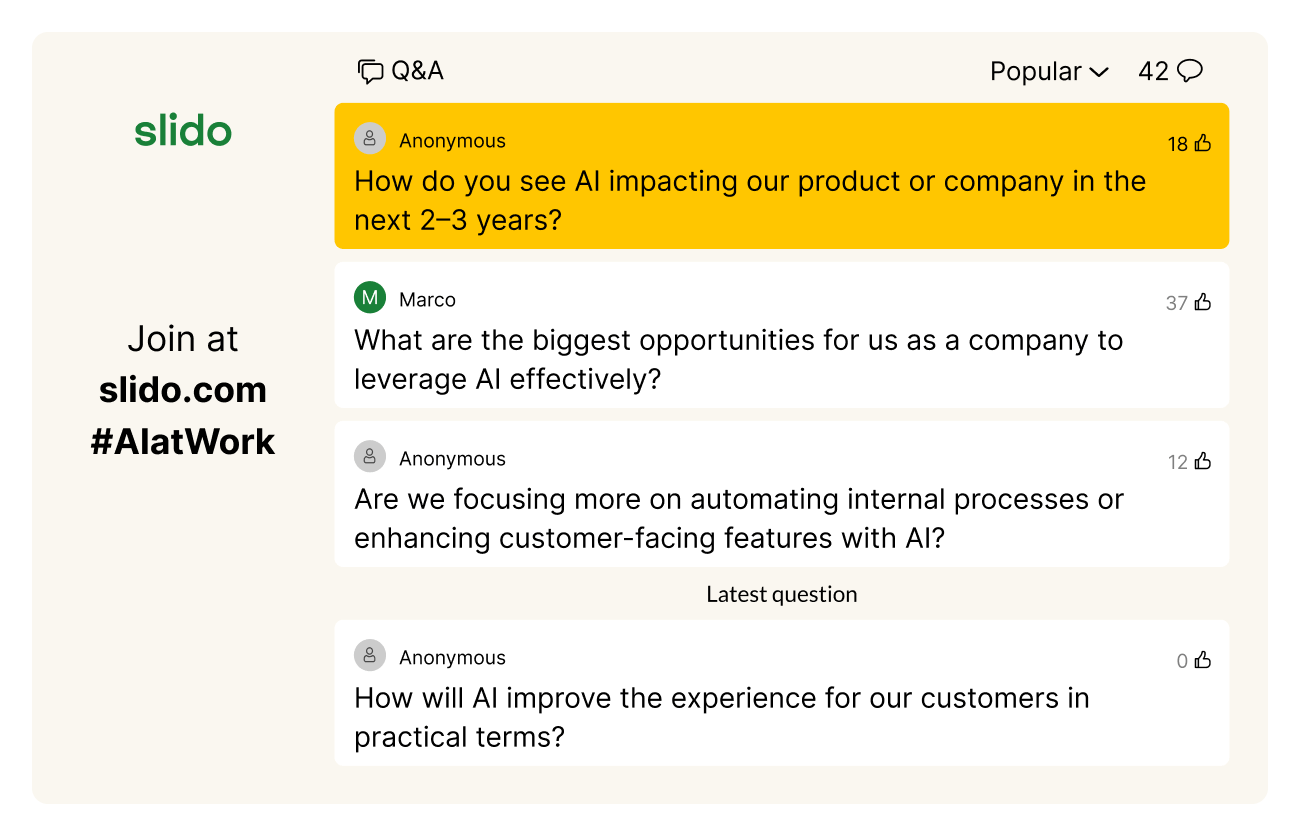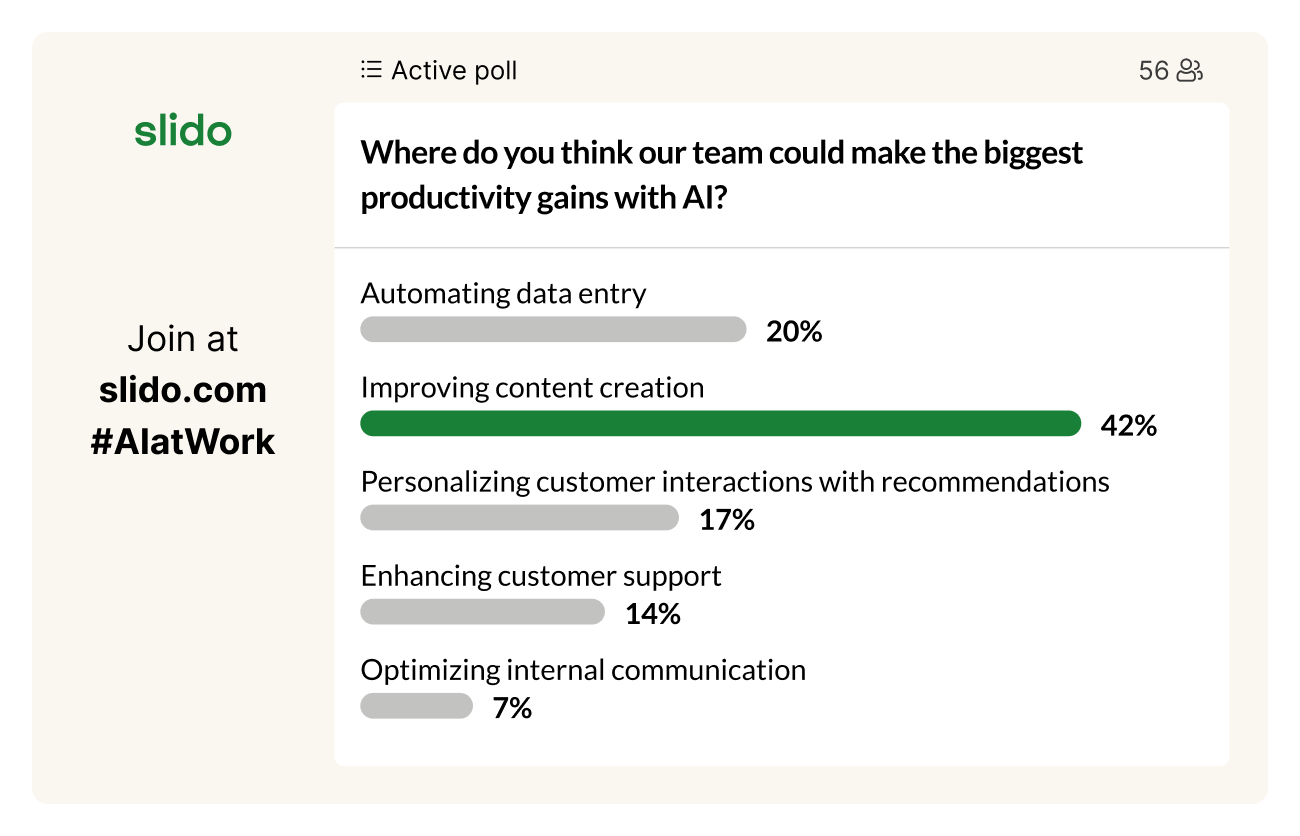AI is everywhere now. It’s a key investment focus for many companies – be that in improving internal efficiencies or to evolve the products that they bring to market.
And that means change, a lot of it. Something most humans don’t love. In regular circumstances, change can lead to uncertainty which in turn can impact psychological safety.
And the AI transformation brings another emotion into the mix. Fear. Many employees are asking themselves, “Will I still matter?” A recent study found that employees at organizations undergoing comprehensive AI-driven redesign are more worried about job security (46%) than those at less-advanced companies (34%).
This means AI adoption isn’t just a technological problem. It’s a time that needs strong leadership. So, how do we continue to show up as truly human leaders?
Why Human Leadership Still Matters Most
Even with AI doing the heavy lifting, there are three key areas where your human touch as a leader is absolutely essential:
- Building Trust – AI can give us facts and figures, but it can’t build the kind of deep, personal trust that people need to work well together. That’s where you come in, creating an environment where everyone feels safe, respected and heard.
- Driving Engagement – Your role is to keep your team engaged and motivated, helping them see how their work still matters, how they fit into the bigger picture and finding opportunities for their roles to evolve as required. On top of that, many of them need support with adopting AI.
- Connecting on a human level – AI can analyze data and write reports, but it doesn’t understand the nuances of human emotion or know the best way to inspire people. This is where you need to focus on using your empathy and judgment to deliver messages effectively.
In this piece, we’ll share with you some tips for each of these areas to help you lead teams, projects and everything in between.
Building Trust
Trust is the fundamental bedrock upon which performance and innovation are built. When people feel valued, heard and included they’re more likely to embrace change.
But trust goes beyond interpersonal relationships in your team with AI transformation. Does your team have trust in the solutions you are implementing? Do the AI tools fit within your company’s compliance expectations?
Michael C. Bush, CEO of Great Place to Work sums it up nicely:
“If I could create a backdrop for the world right now, I’d spell out the word trust as large as I could. That’s what the conversation around AI and workplace dynamics is all about. Employees must understand how AI affects their workflows to fully embrace its potential, and this culture of trust must extend to building confidence in AI systems.”
Cultivating Psychological Safety
A key foundation for building trust comes through psychological safety – the shared belief that all members of a team are safe to take interpersonal risks. As Google’s multi-year “Project Aristotle” study proved, it is the single most important dynamic of high-performing teams.
Here are three behaviors to model immediately:
- Practice Empathy: The transition to AI is fraught with anxiety. Actively listen to and validate your employees’ concerns. Your job isn’t to dismiss their fears but to address them with honesty and support.
- Acknowledge Your Own Fallibility: You don’t have all the answers and admitting that is a superpower. Simple statements like, “I may be missing something here, what are your thoughts?” create space for others to be vulnerable, ask questions and contribute their own insights.
- Frame Work as a Learning Problem: Shift your team’s focus from error-free execution to collective learning. In an uncertain territory, the goal is not to be right the first time but to learn and adapt the fastest. More so with AI around.
💡Pro Tip: Make it easier with these 5 Slido Activities to Build Psychological Safety In Your Team.
Increase Trust in AI solutions
BCG found that the share of employees who feel positive about GenAI rises from 15% to 55% with strong leadership support.
A recent study found that 75% of employees would be more accepting of AI if companies were more transparent about its use. The problem compounds when leaders focus exclusively on efficiency metrics. Teams might show impressive productivity gains from AI tools while simultaneously experiencing declining morale, increased anxiety about job security and eroding interpersonal trust.
Why not dedicate your next team meeting to the topic of AI adoption?
By creating time to highlight and share examples within your team meetings, you can identify where your team might have challenges as well as enable them to inspire one another.
You can use a combination of anonymous polls and anonymous Q&A in order to encourage your team to feel safe to open up and keep the conversation on point. You can also invite an expert on AI implementation from your company to join you for an Ask Me Anything session.

#2 Driving Engagement
That ‘Will I still matter?’question that both you and your team might be asking, creates a challenge for employee engagement.
While AI can help us to do truly meaningful work, increased automation can lead us to questioning if we’re adding value.
In a study of 1700 working adults, 93% of those who felt valued said they were motivated to do their best. 88% were engaged at work.
In most cases, as a team leader, you are responsible for ensuring your team feels valued and continues to feel their roles are relevant.
Your Action Plan: From Automation to Meaningful Work
- Confront the Fear Proactively: Communicate transparently and regularly about how roles will evolve, along with creating space for your team to upskill or reskill
- Become a Job Redesigner: Your role is to identify where your team could make productivity gains with AI and where you can create more space for the work that humans excel at: creative problem-solving, strategic planning, innovation and building deep client relationships.
- Personalize Engagement: Run regular real-time pulse checks on team morale. This can enable you to understand where your team is at and take them along with you

Help people understand why change is happening
One of the most impactful things you can do as a leader is to help your team understand what changes you’re planning and why.
When it comes to change:
- 45% of employees resist change as they generally like to remain in the status quo
- 85% don’t understand the rationale behind leaders’ strategy to change
- 86% of workers say there’s a lack of clear communication around situations transitioning – which leads to changes failing
Involving your team from the beginning and communicating clearly what to expect can increase the likelihood of achieving your goals.
Slido can help you to involve your team with any changes you’re looking to make around integrating AI to your workflow with live polls such as:
- What part of your current work do you believe could be supported (not replaced) by AI, making your role more meaningful?
- How are you using AI in your personal life?
- What training or resources would make you feel more confident and competent using AI in your role?
- What challenges do you anticipate, and how can we address them together?
You can brainstorm ideas along with your team to gather suggestions. The team can then vote on priorities for training, feature development or process changes. All of this will increase their engagement and get them more onboard with any changes you want to make.
💡Pro Tip: Get insights from a neuroscience expert on change from our Slido Elevate recap
#3 Connecting on a human level
AI is great at efficiently summarizing meetings, organizing knowledge and even drafting routine emails, but it can’t manage the anxiety of an employee who received critical feedback during that meeting.
Your most powerful leadership skill in the age of AI is your ability to listen deeply.
Your Action Plan: A Playbook for Human-Centric Communication
- Master the Art of Storytelling: Data and logic are not enough to drive change. Help your team understand their place in the journey and how this transformation helps achieve a shared (ideally inspiring) mission.
- Be the First and Most Trusted Source: Proactively communicate your AI strategy, its goals and its impact. By controlling the narrative with honesty, you bust myths before they can take root.
- Counterbalance Efficiency with Connection: As a leader, consciously create structured opportunities for rich human connection such as team check-ins, collaborative “what-if” sessions and social gatherings.
- Gather feedback often: Check in through all your team touchpoints to understand how everyone is feeling, where they see opportunities and where they’re facing challenges.
The real power of team communication comes from unlocking everyone’s voices by creating space for everyone to speak up.
Slido can help you to create the space for human connection, clarity and courage. It can also act as your meeting facilitator in your meetings, from enabling connection over an icebreaker, to checking for understanding after presenting something new with a rating poll asking: ‘How well have you understood how this change will impact your day-to-day work?’.
💡Pro Tip: Not that confident in facilitating? Check out our facilitation tips in the Slido Academy
Evaluating your communication
It’s also important to look at how well you’re communicating with your team during times of change. You can do this by directly asking where your team stands on statements like: “I understand how AI will affect my role,” and “Leadership is honest about the challenges of AI.”
Your end goal should be to get to 85% agreement which might take you some time to work up to. By creating space for comments, you can also receive insights on what you need to improve.
💡You can learn more about How Communication Boosts Team Morale.
Leading in the AI age
Leadership in the age of artificial intelligence isn’t about having all the answers, it’s about being the anchor for your team amongst the neverending change we’re facing in our working lives.
It’s your role to to double down on the world of humanity, on rallying around an inspiring vision, fostering psychological safety and building deep, meaningful connections between your team.
The ultimate competitive advantage in the age of AI will not be found in superior algorithms, but in the organizations that successfully incorporate human-AI collaboration through human leadership.
Ready to lead with more empathy, trust, and clarity?




